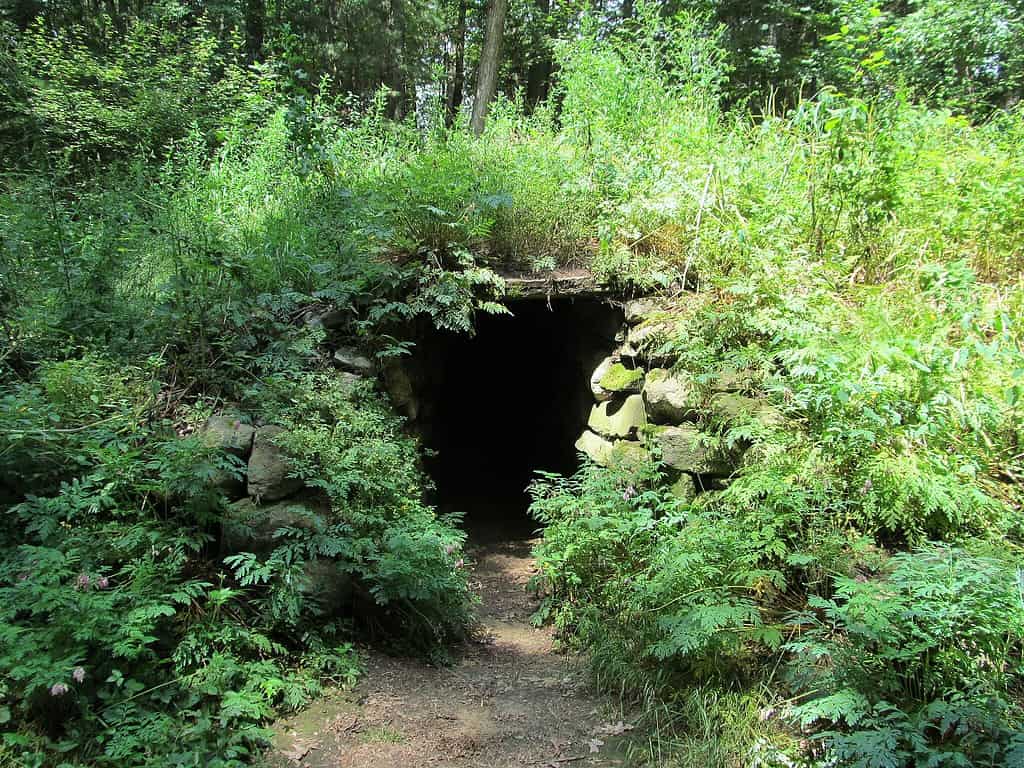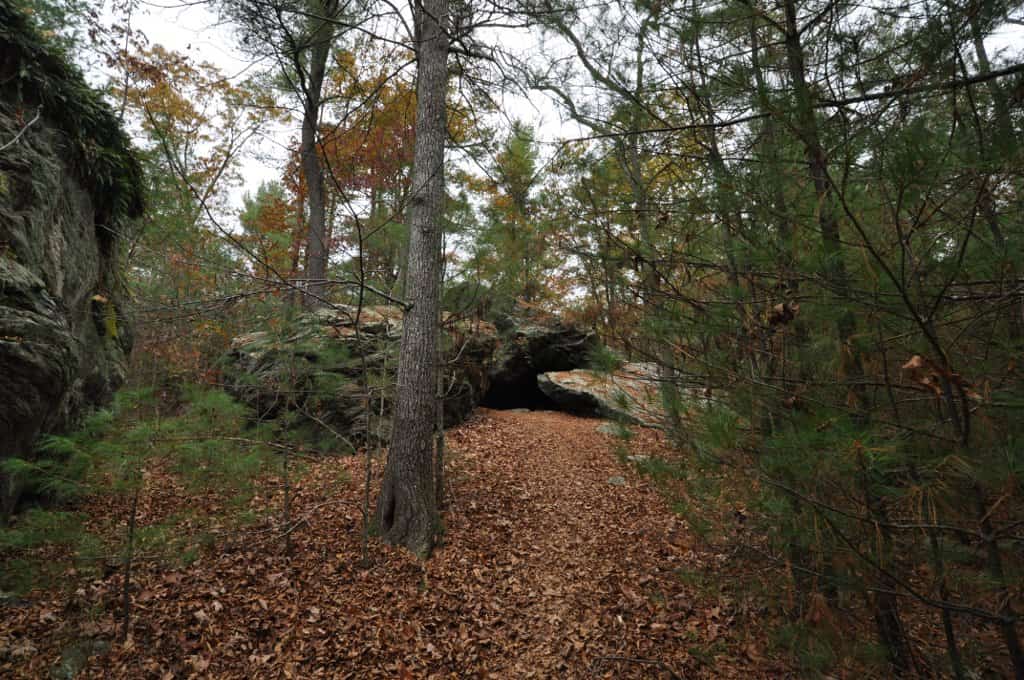They may be less frequent in the state, but caves in Massachusetts are just as amazing and thrilling here as anywhere else in the country. And, perhaps, just a hint more so for some, since they’re a bit more unexpected than someplace like Oregon or Montana.
Let’s take a look at the best and most intriguing caves in Massachusetts, from the well-known Devil’s Den and newly news-making Bat Cave to the lesser-known Sunderland Caves.
Nashoba Brook Stone Chamber/”Potato Cave”

Nashoba Brook Stone Chamber, Acton Massachusetts, known as “Potato Cave” is a popular choice. You can explore this cave in Massachusetts without a tour guide or permit.
Lying about 30 minutes from Boston, in Acton, Massachusetts, the “Potato Cave” or the Nabosha Brook Stone Chamber as it’s officially known, sees frequent visitors. The cave earned its nickname from the assumption that the L-shaped chamber was used, once upon a time, as a root cellar in the 18th or 19th Century when it was constructed. The cave lies within the Nashoba Brook Conservation Area, tucked into a hill and accessed by a long entry passage near Mill Dam Road.
The structure, made of stone, has been researched and excavated by archeologists who agree with the legend: this once was used to store food. Some think it may have been a precolonial structure used by First Nations peoples, but local lore leans towards its use by former railroad workers in the 1800s.
The chamber had fallen into disrepair at some point, but the Acton Trail Through Time group helped to restore the cave, along with other points of interest nearby. The low-ceilinged chamber requires crouching from visitors in the entry passage but the chamber itself is tall enough to stand in. The ceiling, made from huge stone slabs, helps to create the dry, sandy floor below.
Now, visitors may enter the chamber via the passage, with no tour or guide required. No entry fee is required, and the chamber is open all day, any time of the year.
Upton Heritage Park

A historical map of Upton, Massachusetts, home to Upton Heritage Park.
The underground chamber, situated in Upton Heritage Park, was built by some unknown person many years ago. The space is the largest and most intricate of its kind in all of New England, and so draws history buffs and explorers looking for something different.
The Upton Heritage Park, where the cave rests, lies about 37 miles from Boston. Many theories fly around as to who could have built this unique structure. Some believe it to be pre-Columbus European explorers, others believe it was the First Nations in the area who built it. Yet others theorize it might have been early American farmers intent on storing crops. Some even think it could have been a leather tanner from the 1800s.
The chamber rests under a hillside, with a beehive-shaped dome chamber of quarried stones, 12 feet across and 11 feet high. The roof is made of several large, oval stones, each weighing several tons. The dome has a 14-foot long, 6-foot-tall entrance tunnel, with the stone-lined cave totally dark once you enter.
You may visit the site yourself, without a tour guide or entry fee.
King Philip’s Cave

Entrance to the cave in which Metacom aka “King Philip” is said to have hidden. The site has become one of the more explored caves in Massachusetts.
Likely the best-known cave in Massachusetts, King Phillip’s Cave rests in Norton. The cave received its name from King Philip’s War between 1675 and 1676, when the armed conflict was meant to evict English settlers from the New England area. The war wages between European settlers and Metacom, and the Nipmucks, Pocumtucks, Narragasnetts, and Wampanoags, the First Nations peoples of the area. Metacom was killed during the conflict and ultimately, the land was claimed by the English. King Philip’s Cave is believed to have hidden Metacom (King Philip, the name given him by the settlers) during the struggle.
Carved out by glaciers during the last Ice Age, the cave winds up being a bit challenging to spot now. Of course, as a hiding place, that meant the cave served its purposes well.
The cave isn’t very large, but you can enter via Stone Run Drive along Bay Road. No tours are available, nor fees required to enter the intriguing historical cave.
Belcher’s Cave
Named for a criminal named Belcher, Belcher’s Cave contains a natural chamber of 30 feet in length and 10 feet in width. Locals and tourists alike visit this unique underground structure in Great Barrington, Massachusetts. The cave basically looks like an entryway into the hillside, with a dimly lit interior.
According to legend, Belcher’s Cave became the first underground hideout for criminals in America, when, in 1765, Gill Belcher left Connecticut to flee the law. He had apprenticed as a silversmith in his former state but was convicted of counterfeiting Spanish dollars in 1764. He broke out of jail and escaped to Massachusetts, where allegedly he hid away in this cave. Supposedly, the cave rested beside his new home and became the location for his new counterfeiting operations. The blackened walls of the cave imply that there certainly was smoke inside at some point, and folks believe this is evidence of Belcher’s fires within for his counterfeiting work. But, he was caught and brought to New York where he was convicted and hanged in 1773.
Belcher’s Cave is believed to have been formed by a geological fault. This fault formed the grottoes into the hard rocks, with a wide portal and narrow passageways. The cave has no special geological formations within it but remains a popular spot for locals and tourists in the area. Anyone can visit the cave and explore, though folks should be warned that rattlesnakes have occasionally been spotted inside.
The Devil’s Den
Located near Ashland, Massachusetts, the Devil’s Den is, perhaps, one of the best-known caves in this part of the state, even if it’s not the largest. The cave rests near the grandstands of the local high school football field, along the edge of a small cliff. The cave once gave the colonial settlers the creeps. The Puritans of the day feared the cave’s supposed resident, the devil. Likely, this fear arose because of the unfamiliar terrain and unusual (to them!) animal noises heard from within.
The talus cave came to be via irregularly shaped rocks piling atop one another and forming the odd site. Archeologists have discovered evidence of First Nations’ activity within and around the cave. The local historical society had to fight for the cave’s preservation, as well. This happened when the high school attempted to expand the athletic fields into the area, which would have damaged the cave and surrounding terrain. The cave was saved, though. And now you can easily access this point via trails up the hill and through the wooded areas surrounding. No permits or tours are required for visiting the Devil’s Den, but standard cave exploration precautions should be exercised.
Horse Caves

The Horse Caves, on the eastern slope of Mount Norwottuck, in Granby, Massachusetts. Folks explore the caves fairly often while out hiking.
Near Granby, Massachusetts, the Horse Caves reside within the Holyoke Range. They technically make up ledges and “holes” more than traditional caves. The Horse Caves rest along the New England National Historic Scenic Trail, east of the summit of Mount Norwottuck. Supposedly, the caves once welcomed Daniel Shays and his men. This occurred during the Revolutionary period, during the Shays’ Rebellion after they met with defeat by the Massachusetts militia.
Today, the ledges may be walked beneath, with the huge rock balancing overhead on top of other rocks. Beneath the ledges, you’ll have a clear view of the trails and wooded lands. But before you get to the cave, you’ll need to crawl through a narrow opening. Then, you’ll go through a tunnel before you get to the small opening at the other end where only a hand may fit in.
You’ll find most of the activity in the area involves hiking and this unique cave experience. But you’ll still need to wear appropriate clothing, proper footwear, and plan for some underground exploration.
Berkshire Bat Cave
Located in the hills of Northfield Mountain, the Berkshire Bat Cave has gained a reputation as the power source for thousands of homes in New England. Beneath the water of the lake here, a tunnel, which some have described as a “villain’s lair” leads to the Bat Cave of the Berkshires. The cavern is massive, large enough to fit a five-story building into it.
Despite the name, bats don’t always live here. The power plant, generating 292 megawatts each via four turbines could be the reason, but the implications are that they simply don’t like being there that often anyway.
Because of the power plant down there, the Bat Cave, sadly, may not be explored. It remains one of the most incredible caves in the state, though!
Sunderland Caves
Situated near the University of Massachusetts in Mount Toby Forest near Sunderland, the Sunderland Caves rest along a fair hiking trail. The trail goes for 3 miles, along a moderate grade. This means most folks can make the hike if they have some fitness skills. The hike to the cave begins at a parking lot, and then follows the Robert Forest Trail. The trail opens to reveal the caves which appear to be large rock formations. If you approach, you’ll see a chasm open up between the tree split. This is Sunderland Caves. Follow the trail around the chasm. Here you can access an overlook for the Connecticut River and Pocumtuck Ridge or head past to the cave entrance. The entrance goes in at least 30 feet, with the cave going further in. You’ll need a flashlight to explore, though, as there is no tour available or established lighting.
Summary of 8 Amazing Caves in Massachusetts
| Cave | Location | |
|---|---|---|
| 1 | Nashoba Brook Stone Chamber (“Potato Cave”) | Acton |
| 2 | Upton Heritage Park | 37 Miles from Boston |
| 3 | King Philip’s Cave | Norton |
| 4 | Belcher’s Cave | Great Barrington |
| 5 | Devil’s Den | Near Ashland |
| 6 | Horse Caves | Near Granby on Holyoke Ranch |
| 7 | Berkshire Bat Cave | The hills of Northfield Mountain |
| 8 | Sunderland Caves | Near the University of Massachusetts in Mount Toby Forest near Sunderland |
Thank you for reading! Have some feedback for us? Contact the AZ Animals editorial team.








